I realize that it’s been some time since I posted here. I have been deep in the subterranean autoharp mines stoking the steam driven sawdust grinders, board stretchers, and string breakers that produce the custom instruments that I create for my many wonderful customers… I only just emerged for a hot shower, a cold adult beverage and to catch up on some news of the world. Building custom stringed instruments and strumming newly minted autoharps takes me to a comforting place apart from much of the disturbing social, political, and environmental reports. Like our music, it is a soothing embrocation to be applied to the psychological pains and strains of daily life.
So, what have I been doing? Besides completing some autoharp orders, I am currently involved in long term projects creating two non-traditional zithers, one for a musician who preforms classical Indian ragas and another for a Nashville based multi-instrumentalist.
 Along the way I have made a couple of improvements on my “Child ‘Harps”. I had been making slotted chord bar holders by cutting down the manufactured plastic holders once produced by Oscar Schmidt. These work well but are a bit noisy when the wooden bars “clack” against the hard plastic. My newer Child ‘Harps now have the quieter Delrin and steel pin combs as on my standard sized autoharps.
Along the way I have made a couple of improvements on my “Child ‘Harps”. I had been making slotted chord bar holders by cutting down the manufactured plastic holders once produced by Oscar Schmidt. These work well but are a bit noisy when the wooden bars “clack” against the hard plastic. My newer Child ‘Harps now have the quieter Delrin and steel pin combs as on my standard sized autoharps.
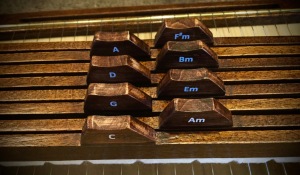 Child ‘Harps have carried seven chords in two rows. I now offer eight chords. Here is the G/D diatonic version.
Child ‘Harps have carried seven chords in two rows. I now offer eight chords. Here is the G/D diatonic version.
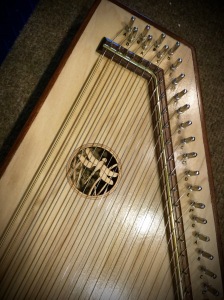 As with the Child ‘Harps’ larger siblings, laser cut sound hole rosettes are popular. there is a variety of styles available in this smaller size for this smaller autoharp.
As with the Child ‘Harps’ larger siblings, laser cut sound hole rosettes are popular. there is a variety of styles available in this smaller size for this smaller autoharp.
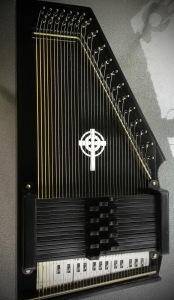 A more recent build is this thirty-six string, fifteen chord chromatic I built for a gentleman just beginning his autoharp journey. His preferences included a Celtic cross sound hole rosette, an all black finish, and a salvaged OS tuning label at the anchor end.
A more recent build is this thirty-six string, fifteen chord chromatic I built for a gentleman just beginning his autoharp journey. His preferences included a Celtic cross sound hole rosette, an all black finish, and a salvaged OS tuning label at the anchor end.

He plans to play his new autoharp horizontally, on his lap, and strumming below the chord bars. For that, I moved the chord set closer to the angled bridge to allow more space below.
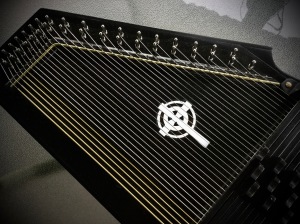 This instrument resembles the old black model A autoharps of the past but features all of my modern improvements for tone, volume, stability, and play ability.
This instrument resembles the old black model A autoharps of the past but features all of my modern improvements for tone, volume, stability, and play ability.
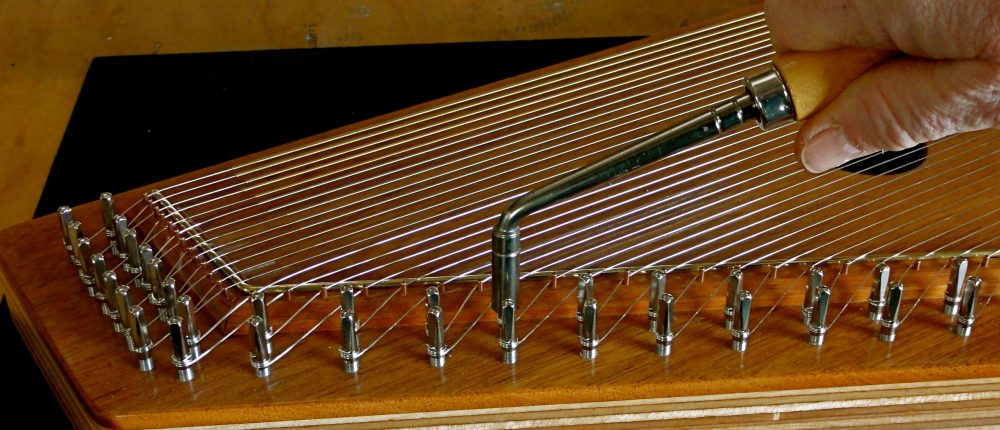
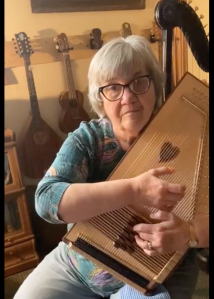
 This thirty-seven string, fifteen chord diatonic autoharp plays in the keys of G and D. The Sitka spruce soundboard features a weeping heart sound hole and curly maple bridges. Walnut trims the sides, chord bar buttons, and tailpiece.
This thirty-seven string, fifteen chord diatonic autoharp plays in the keys of G and D. The Sitka spruce soundboard features a weeping heart sound hole and curly maple bridges. Walnut trims the sides, chord bar buttons, and tailpiece.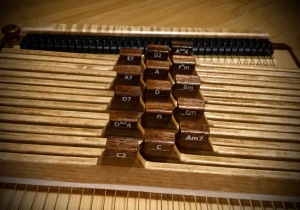 The fifteen maple chord bars are arranged in a custom, three row layout.
The fifteen maple chord bars are arranged in a custom, three row layout.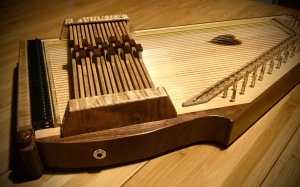 Added options are Daigle fine tuners and a Schreiber electromagnetic pickup.
Added options are Daigle fine tuners and a Schreiber electromagnetic pickup.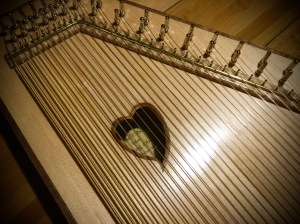
 I recently completed is this thirty-seven string diatonic autoharp in the single key of A. I built it for ourselves because Marsha and I are trying to sing along with our instruments more and find that the key of A is a comfortable range for our voices. Being a single key diatonic, it has paired string courses in the middle octave and only the notes needed for chords in the key of A. This produces a very rich and full tone that works nicely for strumming accompaniment and playing melody.
I recently completed is this thirty-seven string diatonic autoharp in the single key of A. I built it for ourselves because Marsha and I are trying to sing along with our instruments more and find that the key of A is a comfortable range for our voices. Being a single key diatonic, it has paired string courses in the middle octave and only the notes needed for chords in the key of A. This produces a very rich and full tone that works nicely for strumming accompaniment and playing melody.
 Fifteen chords are arranged in a “Bowers” type setup with major chords in the center row, sevenths in the top row, and minors in the bottom row. This familiar arrangement is in place on all of Marsha’s instruments and permits a sort of “motor memory” to kick in when she changes from one autoharp to another, even if in different keys. Seven of the chords are “color chords” for enhanced arrangements.
Fifteen chords are arranged in a “Bowers” type setup with major chords in the center row, sevenths in the top row, and minors in the bottom row. This familiar arrangement is in place on all of Marsha’s instruments and permits a sort of “motor memory” to kick in when she changes from one autoharp to another, even if in different keys. Seven of the chords are “color chords” for enhanced arrangements. The instrument has a 1/4 inch thick solid spruce soundboard. The one piece frame is laminated maple pinblock with a laminated maple back. The side veneer, end cover, and chord bar covers are made of curly maple. Chord bars are maple with alternate bars painted black. Black tuning pins, bridges, Schreiber fine tuners, and purfling complete the black/white motif.
The instrument has a 1/4 inch thick solid spruce soundboard. The one piece frame is laminated maple pinblock with a laminated maple back. The side veneer, end cover, and chord bar covers are made of curly maple. Chord bars are maple with alternate bars painted black. Black tuning pins, bridges, Schreiber fine tuners, and purfling complete the black/white motif.
 I have recently completed three of my 3/4-size autoharps that are for sale and will soon be ready for delivery.
I have recently completed three of my 3/4-size autoharps that are for sale and will soon be ready for delivery. The design and construction is fundamentally the same as my full sized instruments. For structural integrity and tuning stability I build with one- piece laminated frames, and solid wood soundboards and components. They have a rich full voice for their size and are built to last.
The design and construction is fundamentally the same as my full sized instruments. For structural integrity and tuning stability I build with one- piece laminated frames, and solid wood soundboards and components. They have a rich full voice for their size and are built to last.




 I recently completed and delivered this commissioned instrument to a musician in New York state. After the initial contact and much discussion by e-mail, the entire process required only three months. The wait probably seemed longer to the musician anxious to receive his first luthier built autoharp but its completion was well within my usual two to five month time estimate.
I recently completed and delivered this commissioned instrument to a musician in New York state. After the initial contact and much discussion by e-mail, the entire process required only three months. The wait probably seemed longer to the musician anxious to receive his first luthier built autoharp but its completion was well within my usual two to five month time estimate.

 The chord bars, bridges, side veneer, chord bar covers, and tail cover are made of African mahogany stained with Minwax red mahogany oil stain. The chord bar covers, chord buttons, and tail cover are capped with curly maple finished natural. The soundboard is spruce, the back is maple veneer, and everything is finished with up to six coats of semi-gloss Deft lacquer.
The chord bars, bridges, side veneer, chord bar covers, and tail cover are made of African mahogany stained with Minwax red mahogany oil stain. The chord bar covers, chord buttons, and tail cover are capped with curly maple finished natural. The soundboard is spruce, the back is maple veneer, and everything is finished with up to six coats of semi-gloss Deft lacquer. The Schreiber electromagnetic pickup is specially wound for this thirty-seven string array and is fastened underneath the chord bars by metal tabs that fit in slots on the underside of the Delrin chord bar combs. A small length of coax is routed through the inside of the instrument to a 1/4″ jack.
The Schreiber electromagnetic pickup is specially wound for this thirty-seven string array and is fastened underneath the chord bars by metal tabs that fit in slots on the underside of the Delrin chord bar combs. A small length of coax is routed through the inside of the instrument to a 1/4″ jack. Many of my autoharps are shipped out of state and abroad to musicians who will likely want to experiment with alternative chords or attend to future DIY adjustments and repairs. For this I include some extra blank felted chord bars, extra chord felt, self adhesive under cover felt, and extra springs. The wrapper from the custom string set will help them order the proper strings when it becomes necessary and a laminated strip indicates the tuning of each string. Also included is the allen wrench that comes with the fine tuners and a new star tipped T-wrench.
Many of my autoharps are shipped out of state and abroad to musicians who will likely want to experiment with alternative chords or attend to future DIY adjustments and repairs. For this I include some extra blank felted chord bars, extra chord felt, self adhesive under cover felt, and extra springs. The wrapper from the custom string set will help them order the proper strings when it becomes necessary and a laminated strip indicates the tuning of each string. Also included is the allen wrench that comes with the fine tuners and a new star tipped T-wrench. The latest from here at Fretnot Laboratories is this custom thirty-seven string, fifteen bar diatonic in the keys of G and D. It features Daigle fine tuners, two lock bars, flat chord bar buttons, and five extra blank chord bars for future substitutions. A custom oval rosette was fashioned using walnut burl and plastic white-black-white purfling. Walnut burl also trims the tops of the chord bar covers and the tail end cover.
The latest from here at Fretnot Laboratories is this custom thirty-seven string, fifteen bar diatonic in the keys of G and D. It features Daigle fine tuners, two lock bars, flat chord bar buttons, and five extra blank chord bars for future substitutions. A custom oval rosette was fashioned using walnut burl and plastic white-black-white purfling. Walnut burl also trims the tops of the chord bar covers and the tail end cover.

 The latest autoharp to emerge from my workshop is this thirty-seven string diatonic beauty ordered only two months ago by an autoharp friend named Lori. She currently plays chromatic autoharps and was amazed at the richer tone and greater volume of a two key diatonic. She often plays in the key of D with a dulcimer group but also finds the keys of G, C, and A useful. This diatonic is primarily set up for the keys of D and G but with the addition of a single F string can play the F chord needed for the key of C. The key of A is also present with the chords A, D, and a partial E7.
The latest autoharp to emerge from my workshop is this thirty-seven string diatonic beauty ordered only two months ago by an autoharp friend named Lori. She currently plays chromatic autoharps and was amazed at the richer tone and greater volume of a two key diatonic. She often plays in the key of D with a dulcimer group but also finds the keys of G, C, and A useful. This diatonic is primarily set up for the keys of D and G but with the addition of a single F string can play the F chord needed for the key of C. The key of A is also present with the chords A, D, and a partial E7. Two of the fifteen chord bars are lockbars. They are fitted with small sliding Delrin locks on each end that slide under the chord bar holder caps. There is a G lockbar and a D lockbar. When locked down the bar mutes those notes not used in that key so they cannot be played accidentally.
Two of the fifteen chord bars are lockbars. They are fitted with small sliding Delrin locks on each end that slide under the chord bar holder caps. There is a G lockbar and a D lockbar. When locked down the bar mutes those notes not used in that key so they cannot be played accidentally.



You must be logged in to post a comment.